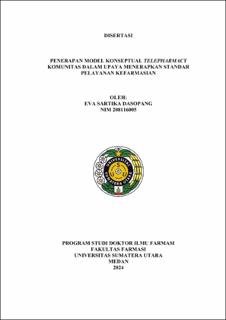| dc.description.abstract | Community pharmacists, despite their business orientation, have an ethical
responsibility to patients to ensure that they receive appropriate therapy. The
pharmacist's professional duty to prevent medication errors and improve patient
compliance is hampered by the low attendance rate of pharmacists. Digitalisation is
a solution, so that pharmaceutical services can still be carried out with limited
distance and time.
The purpose of this study was to examine the application of the Community
Telepharmacy Conceptual Model in an effort to implement pharmaceutical service
standards. This research is a mixed method with cluster sampling, for validity and
reliability alpha testing (32 respondents), beta testing (30 respondents), accepted
testing (150 respondents) and 100 respondents for service quality, satisfaction, trust,
loyalty and compliance. Multiple linear regression test to measure the effect of
service quality, satisfaction and trust on patient loyalty and Mann-whitney test to
measure compliance improvement using 302 respondents. Data was obtained from
questionnaires distributed to respondents who had degenerative diseases in the mild
to moderate category. The results analysed using SPSS version 26.0 showed that all
questionnaires were valid and reliable.
The Telepharmacy application developed meets system feasibility and is
feasible to apply in community pharmacy. Levels of service quality, trust, loyalty,
satisfaction and compliance with percentages of 70.89%, 71.68%, 74.37%, 73.92%,
and 85% respectively. The application of Telepharmacy has an effect on improving
service quality, satisfaction, trust, loyalty and compliance of patients taking drugs
with a p value <0.05. The highest increase in income occurred in middle income
pharmacies 45.86% followed by low income and high income 31.44% and 16.25%. | en_US |


